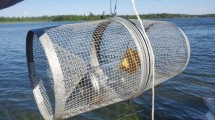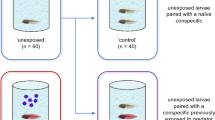Summary.
Many aquatic prey are known to use chemical alarm cues to assess their risk of predation. In fishes, such alarm cues can be released either through damage of the epidermis during a predatory attack (capture-released) or through release from the predator feces (diet-released). In our study, we compared the importance of capture- versus diet-released alarm cues in risk assessment by fathead minnows (Pimephales promelas) that were naïve to fish predators. We utilized two different fish predators: a specialized piscivore, the northern pike (Esox lucius) and a generalist predator, the brook trout (Salvelinus fontinalis). Handling time of pike consuming minnows was much shorter than for trout consuming minnows, likely resulting in less epidermal damage to the minnows during attacks by pike. In accordance with this, minnows showed a less intense antipredator response to capture-released cues from pike than capture-released cues from trout. This represents a paradox in risk assessment for the minnows as they respond to the specialized piscivore, the more dangerous predator, with a less intense antipredator response. In contrast, the minnows showed a stronger antipredator response to the specialized piscivore than to the generalist when given diet cues. This work highlights the need for researchers to carefully consider the nature of the information available to prey in risk assessment.
Similar content being viewed by others
Author information
Authors and Affiliations
Corresponding author
Rights and permissions
About this article
Cite this article
Ferrari, M.C.O., Brown, M.R., Pollock, M.S. et al. The paradox of risk assessment: comparing responses of fathead minnows to capture-released and diet-released alarm cues from two different predators. Chemoecology 17, 157–161 (2007). https://doi.org/10.1007/s00049-007-0373-0
Received:
Accepted:
Published:
Issue Date:
DOI: https://doi.org/10.1007/s00049-007-0373-0




